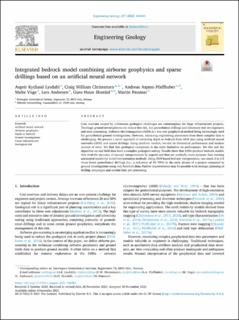Integrated bedrock model combining airborne geophysics and sparse drillings based on an artificial neural network
Lysdahl, Asgeir Olaf Kydland; Christensen, Craig; Pfaffhuber, Andreas Aspmo; Vöge, Malte; Andresen, Lars; Skudal, Guro H.; Panzner, Martin
Peer reviewed, Journal article
Published version
Permanent lenke
https://hdl.handle.net/11250/2994876Utgivelsesdato
2021Metadata
Vis full innførselSamlinger
- NGI articles [1061]
Originalversjon
10.1016/j.enggeo.2021.106484Sammendrag
Cost overruns caused by unforeseen geological challenges are commonplace for large infrastructure projects. Thorough ground investigations can reduce this risk, but geotechnical drillings and laboratory test are expensive and time consuming. Airborne electromagnetics (AEM) is a low-cost geophysical method being increasingly used for geotechnical ground investigations. However, extracting engineering parameters from these complex data is challenging. We present a novel approach of extracting depth to bedrock from AEM data using artificial neural networks (ANN) and sparse drillings. Using synthetic models, we test its theoretical performance and analyse sources of error. We find that geological complexity is the main limitation on performance. We also test the algorithm on real field data from a complex geological setting. Results show that ANNs produce bedrock models that rival the accuracy of manual interpretations by experts and that are markedly more accurate than existing automated resistivity model interpretation methods. Using ANN based bedrock interpretation, one needs 2 to 3.5 times fewer geotechnical drillings (i.e., a reduction of 50–70%) in the early phases of a project compared to ground investigations using only borehole data. Further improvements may be possible with strategic planning of drilling campaigns and careful data pre-processing.
